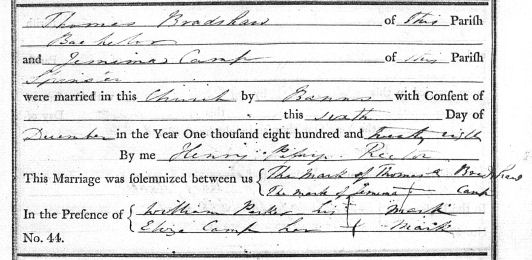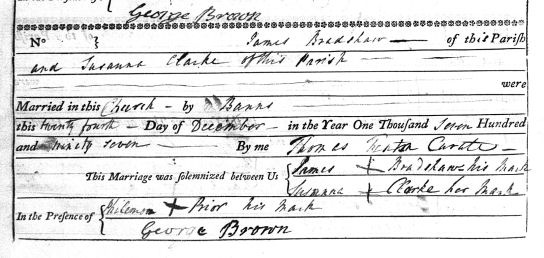|
James BRADSHAW,
Braughing area, 1776 to 1846.
March, 2014
|
|
Margaret Eyre (margeyre @t
bigpond.com) of Wombarra, NewSouth Wales, Australia writes: My GG
grandfather Thomas Bradshaw came
from Hertfordshire to
Australia on the Ramillies in 1855. On
the shipping list he gave his place of birth as
Hertfordshire, his age as 44 his
occupation as labourer, both parents from
Hertfordshire and both were dead Their names were given as
James and
Sarah. He was married to Jemima Camp
at Westmill in 1828. She was born in
Hertfordshire in 1810 Her father
James was dead but mother
Letitia was alive. Searches thru
Ancestry, Find My Past and The Genealogist tracked down several
Thomas Bradshaw's born about 1811 but
the only entry that seemed to fit all the info I had was a birth in 1811
in Thornhill, Yorks West Riding. The
parents were given as James and
Sarah Bradshaw, their abode as
Overton. A search of marriages gave a
marriage of a James Bradshaw to
Sara Thornton in 1803 in
Thornhill, Yorks. The difficulty is
that both Sarah and
James went back to
Hertfordshire to die.
James in
Bishop Stortford in 1846 and Sarah
possibly in Watford in 1837.
Genealogists here in Australia are certain that
the Thomas that came to Australia
and is recorded as living in Westmill
with Jemima and his children on the
1841 census giving his birth place as Herts
and on the 1851 census is in Essex,
occupation, a shepherd, place of birth Herts
is highly unlikely to have been born in Yorks.
Is it possible that James
and Sarah would travel from
Herts to Yorks
to marry, give birth to a son and then go back to
Herts. I have
James on the 1841 census in Union
House Braughing age given 65 which coincides with a birth
from the same area of Braughing
in 1776 for a James Bradshaw.
One of the problems with online data bases
is that they contain so much information that it is usually very easy to
find someone with the "right name and approximately" the right age who is
not your ancestor!
(See Right Name, Wrong Body
to find out how easy it is to get things wrong) In addition they are very
bad at telling you why your ancestor is not recorded in their files! As a
result many people who don't understand the social conditions at the time,
and the limitations of the surviving documentation (and the modern indexes)
get led up the garden path. You should forget about any
Yorkshire connection.
The 1841 census for Thomas
and Jemima and their family seem
straight forward enough - and
FindMyPast shows that the eldest child
William was baptised at Westmill
in 1830, his father being a labourer. This fits in with the following
marriage in 1828 at Westmill:

As one might expect from the fact that
Thomas was a labourer, he clearly could not read and write -
not even being able to write his own name. We can be certain he knew nothing
of the formality of paper records - and if something he said was written
down there was no way he could check its accuracy. This means that we have
to have an open mind when interpreting the
Australian records. Errors could easily have crept in.
So the Australian records
say that his parents were James and
Sarah Bradshaw and they had both died
before 1855. Unfortunately the 1841 census is not as detailed as later
censuses, but if we combine with burial records and if we look we find
the following:
-
A James Bradshaw,
a 65 year old agricultural labourer, living on his own in the
High Street Braughing in 1841.
-
A James Bradshaw,
age not recorded, was buried at Bishops Stortford
on 29 August, 1846.
-
A Sarah Bradshaw,
aged 70 in Ware Union Workhouse in the
1841 census
-
A Sarah Bradshaw,
aged 80, of the parish of Standon, was
buried at the Ware Union Workhouse on 30
March 1851.
-
Westmill,
Standon, and
Braughing are close together and
Bishop's Stortford is not far away.
We can't be certain but this could be the
James and Sarah
that Thomas named as his parents. If
Sarah was seriously infirm in 1841 that could explain her being in the
Workhouse and James being left "at home"
on his own. But if we look for James and
Sarah's marriage we find the following
at Standon in 1820.
This was followed by the baptism of a child,
Charles Bradshaw, at
Standon on 3 June 1821.
But don't panic. Unfortunately the marriage
record does not say - but James could have
been a widower with young children. It was not uncommon for the wife to die
(often in child birth) leaving her husband with young children. When this
happened an unmarried lady (often a relative) moved into the house to look after
the young family ... and no-one was surprised if another child appear less than
9 months after the subsequent marriage.
So let us probe further back when we find a marriage in 1797 at
Braughing:
A number of baptisms can be associated with this marriage.
Eliza and Lydia
were baptised at Braughing in 1798,
followed by William in 1799 - and
Susanna at
Broxbourne in 1802. There was then a very long gap (surely there
must have been other children) until James
was baptised at Braughing in 1814.
Susanna was buried at
Braughing in 1817.
Unfortunately no sign of Thomas
who should have been born around 1811 - but the baptism of
James gives an important clue. All the
earlier baptisms had been in a parish church - but
James was baptised in an Independent Church. But the
Braughing Independent Church records
only start in 1812 - so if Thomas was
baptised there in 1811 no record of the event survives.
So while we haven't got definitive proof proof that
Thomas was the son of
James Bradshaw and
Susanna Clark, everything fits if we assume that (1) the
illiterate Thomas gave the authorities
the name of his step mother, rather than his mother, and (2) there is a good
reason which explains why the relevant birth/baptism record has been lost.
In fact it could be worth you trying to look at the microfilm
of the Braughing Independent Church
Records as these documents often include other valuable information which is
not indexed, such as lists of members, etc. According to the
familysearch web site the
nearest Family Centre where you can order the microfilm is at Cambelltown,
but it might be easier for you to get to Sydney or Woolongong.
The familysearch web site can take you further back -
although I haven't looked further than the baptism of
James Bradshaw at Braughing
on 26 May 1776, the son of Henry and
Sarah Bradshaw. However I did look at
the militia lists for Braughing
(available on CD from the Herts Family
History Society) and these show that Henry
had 3 children in 1773 and 1776. James
would have become eligible for the militia at the age of 18 and he first
appears in the list in 1794.
If you can add to the information given
above tell me.




